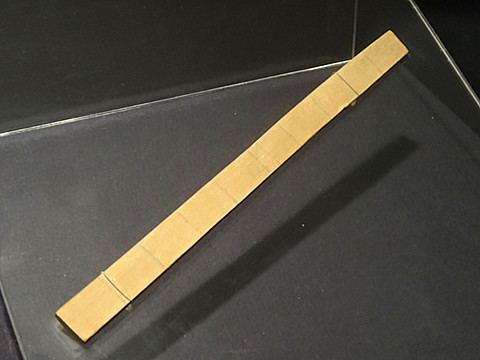Chinese 尺 Wade–Giles ch'ih Jyutping cek3 | Hanyu Pinyin Yale Romanization chek3 Hokkien POJ chhioh | |
 | ||
The chi is a traditional Chinese unit of length. Although it is often translated as the "Chinese foot", its length was originally derived from the distance measured by a human hand, from the tip of the thumb to the tip of the forefinger similar to the ancient Span. It first appeared during China's Shang dynasty approximately 3000 years ago and has since been adopted by other East Asian cultures such as Japan, Korea, and Vietnam. Its present value is standardized around a third of a meter, although the exact standards vary among the mainland of the People's Republic of China, its special administrative region of Hong Kong, and Taiwan.
Contents
In its ancient and modern forms, the chi is divided into 10 smaller units known as cun (the "Chinese inch") and 10 chi together form one zhang.
Modern values
In the People's Republic of China chi has been defined since 1984 as exactly 1/3 of a meter, i.e., 33 1⁄3 cm (approximately 1.094 ft). However, in the Hong Kong SAR the corresponding unit, pronounced chek in Cantonese, is defined as exactly 0.371475 m (exactly 14 5⁄8 in). The two units are sometimes referred to in English as "Chinese foot" and "Hong Kong foot".
In Taiwan, chi is the same as the Japanese shaku, i.e., 10⁄33 of a meter (30.303 cm).
Historical values
The study of ancient rulers and other artifacts whose size in the contemporary chi was known allowed modern researchers to surmise that during the 2nd century BC to 3rd century AD the (Qin Dynasty to Han Dynasty to the Three Kingdoms period), the value of the chi varied between 23.1 and 24.3 cm. Even earlier, during the Warring States era, the value of chi was essentially the same.
It is thought that the ancient Chinese astronomers also used chi as an angular unit; modern analysis of historical records indicates that it may have been equal to one degree.
In the 19th century, the value of chi, depending on the part of the country and the application, varied between 31 and 36 cm. According to an 1864 British report, in most of China the chi used by engineers in public works was equal to 12.71 English inches (32.28 cm), the surveyors' chi was 12.058 inches (30.62 cm), while the value generally used for measuring distances was 12.17 inches (30.91 cm). In Guangzhou, however, the chi used for local trade varied from 14.625 to 14.81 inches (37.15–37.62 cm) – i.e., very close to the modern chek. The value fixed by a Sino-British treaty for the purposes of customs duties in Hong Kong was 14.1 inches (35.81 cm).
Usage in Chinese
Due to its long history and its widespread usage, chi (along with cun) has also seen metaphorical usages in the Chinese language. For example, chi cun (Chinese: 尺寸), a word made up of the units chi and cun, refers to the dimensions of an object, while the idiom "dé cùn jìn chǐ" (simplified Chinese: 得寸进尺; traditional Chinese: 得寸進尺; literally: "gaining a cun and ask for a chi") means "extremely greedy".
In informal use, it is also sometimes used to refer to the US or imperial foot.
